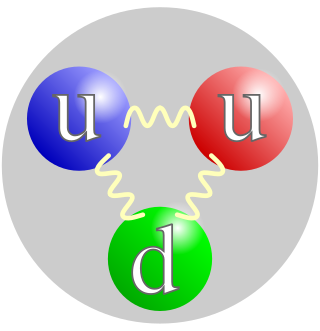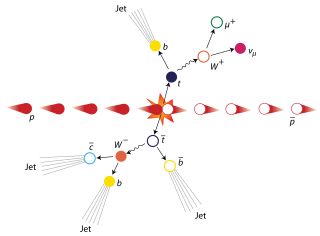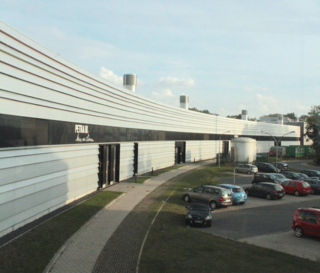Related Research Articles

A gluon is an elementary particle that acts as the exchange particle for the strong force between quarks. It is analogous to the exchange of photons in the electromagnetic force between two charged particles. Gluons bind quarks together, forming hadrons such as protons and neutrons.

A quark is a type of elementary particle and a fundamental constituent of matter. Quarks combine to form composite particles called hadrons, the most stable of which are protons and neutrons, the components of atomic nuclei. All commonly observable matter is composed of up quarks, down quarks and electrons. Owing to a phenomenon known as color confinement, quarks are never found in isolation; they can be found only within hadrons, which include baryons and mesons, or in quark–gluon plasmas. For this reason, much of what is known about quarks has been drawn from observations of hadrons.

The Deutsches Elektronen-Synchrotron, commonly referred to by the abbreviation DESY, is a national research center in Germany. It operates particle accelerators used to investigate the structure of matter, and conducts a broad spectrum of inter-disciplinary scientific research in three main areas: particle and high energy physics; photon science, and the development, construction and operation of particle accelerators. Its name refers to its first project, an electron synchrotron. DESY is publicly financed by the Federal Republic of Germany, the States of Germany, and the German Research Foundation (DFG). DESY is a member of the Helmholtz Association and operates at sites in Hamburg and Zeuthen.
The up quark or u quark is the lightest of all quarks, a type of elementary particle, and a significant constituent of matter. It, along with the down quark, forms the neutrons and protons of atomic nuclei. It is part of the first generation of matter, has an electric charge of +2/3 e and a bare mass of 2.2+0.5
−0.4 MeV/c2. Like all quarks, the up quark is an elementary fermion with spin 1/2, and experiences all four fundamental interactions: gravitation, electromagnetism, weak interactions, and strong interactions. The antiparticle of the up quark is the up antiquark, which differs from it only in that some of its properties, such as charge have equal magnitude but opposite sign.
The down quark is a type of elementary particle, and a major constituent of matter. The down quark is the second-lightest of all quarks, and combines with other quarks to form composite particles called hadrons. Down quarks are most commonly found in atomic nuclei, where it combines with up quarks to form protons and neutrons. The proton is made of one down quark with two up quarks, and the neutron is made up of two down quarks with one up quark. Because they are found in every single known atom, down quarks are present in all everyday matter that we interact with.

The top quark, sometimes also referred to as the truth quark, is the most massive of all observed elementary particles. It derives its mass from its coupling to the Higgs Boson. This coupling is very close to unity; in the Standard Model of particle physics, it is the largest (strongest) coupling at the scale of the weak interactions and above. The top quark was discovered in 1995 by the CDF and DØ experiments at Fermilab.

H1 was a particle detector operated at the HERA collider at the German national laboratory DESY in Hamburg. The first studies for the H1 experiment were proposed in 1981. The H1 detector began operating together with HERA in 1992 and took data until 2007. It consisted of several different detector components, measured about 12 x 15 x 10 meters and weighed 2,800 tons. It was one of four detectors along the HERA accelerator.

In particle physics, a glueball is a hypothetical composite particle. It consists solely of gluon particles, without valence quarks. Such a state is possible because gluons carry color charge and experience the strong interaction between themselves. Glueballs are extremely difficult to identify in particle accelerators, because they mix with ordinary meson states. In pure gauge theory, glueballs are the only states of the spectrum and some of them are stable.
Hadronization is the process of the formation of hadrons out of quarks and gluons. There are two main branches of hadronization: quark-gluon plasma (QGP) transformation and colour string decay into hadrons. The transformation of quark-gluon plasma into hadrons is studied in lattice QCD numerical simulations, which are explored in relativistic heavy-ion experiments. Quark-gluon plasma hadronization occurred shortly after the Big Bang when the quark–gluon plasma cooled down to the Hagedorn temperature when free quarks and gluons cannot exist. In string breaking new hadrons are forming out of quarks, antiquarks and sometimes gluons, spontaneously created from the vacuum.

HERA was a particle accelerator at DESY in Hamburg. It was operated from 1992 to 30 June 2007. At HERA, electrons or positrons were brought to collision with protons at a center-of-mass energy of 320 GeV. HERA was used mainly to study the structure of protons and the properties of quarks, laying the foundation for much of the science done at the Large Hadron Collider (LHC) at the CERN particle physics laboratory today. HERA is the only lepton–proton collider in the world to date and was on the energy frontier in certain regions of the kinematic range.

The Positron–Electron Tandem Ring Accelerator (PETRA) is one of the particle accelerators at the German national laboratory DESY in Hamburg, Germany. At the time of its construction, it was the biggest storage ring of its kind and still is DESY's second largest synchrotron after HERA. PETRA's original purpose was research in elementary particle physics. From 1978 to 1986 it was used to study electron–positron collisions with the four experiments JADE, MARK-J, PLUTO and TASSO. The discovery of the gluon, the carrier particle of the strong nuclear force, by the TASSO collaboration in 1979 is counted as one of the biggest successes. PETRA was able to accelerate electrons and positrons to 19 GeV. Research at PETRA led to an intensified international use of the facilities at DESY. Scientists from China, France, Israel, the Netherlands, Norway, the United Kingdom and the USA participated in the first experiments at PETRA alongside many German colleagues.

In particle physics, a three-jet event is an event with many particles in final state that appear to be clustered in three jets. A single jet consists of particles that fly off in roughly the same direction. One can draw three cones from the interaction point, corresponding to the jets, and most particles created in the reaction will appear to belong to one of these cones. These events are currently the most direct available evidence for the existence of gluons, and were first observed by the TASSO experiment at the PETRA accelerator at the DESY laboratory.
Event generators are software libraries that generate simulated high-energy particle physics events. They randomly generate events as those produced in particle accelerators, collider experiments or the early universe. Events come in different types called processes as discussed in the Automatic calculation of particle interaction or decay article.
JADE was a particle detector at the PETRA particle accelerator at the German national laboratory DESY in Hamburg. It was operated from 1979 to 1986. JADE's most important scientific achievement was the discovery of the gluon in three-jet events. It also helped greatly in establishing quantum chromodynamics. JADE is an acronym for Japan, Deutschland (Germany) and England, the three countries from which the participating universities originated. The JADE jet chamber is now exhibited in the physics lecture hall at the University of Heidelberg. Although the last data with JADE were taken in 1986, analysis continued, with the most recent paper published in 2012. In 1995, the European Physical Society (EPS) awarded a "Special High Energy and Particle Physics Prize" to the JADE, PLUTO, TASSO and MARK-J collaborations at PETRA for "establishing the existence of the gluon in independent and simultaneous ways".
Bjørn Håvard Wiik was a Norwegian elementary particle physicist, noted for his role on the experiment that produced the first experimental evidence for gluons and for his influential role on later accelerator projects. Wiik was director of DESY, in Hamburg, Germany, from 1993 until his death.

Quark–gluon plasma is an interacting localized assembly of quarks and gluons at thermal and chemical (abundance) equilibrium. The word plasma signals that free color charges are allowed. In a 1987 summary, Léon van Hove pointed out the equivalence of the three terms: quark gluon plasma, quark matter and a new state of matter. Since the temperature is above the Hagedorn temperature—and thus above the scale of light u,d-quark mass—the pressure exhibits the relativistic Stefan-Boltzmann format governed by temperature to the fourth power and many practically massless quark and gluon constituents. It can be said that QGP emerges to be the new phase of strongly interacting matter which manifests its physical properties in terms of nearly free dynamics of practically massless gluons and quarks. Both quarks and gluons must be present in conditions near chemical (yield) equilibrium with their colour charge open for a new state of matter to be referred to as QGP.
TASSO was a particle detector at the PETRA particle accelerator at the German national laboratory DESY. The TASSO collaboration is best known for having discovered the gluon, the mediator of the strong interaction and carrier of the color charge. Four TASSO scientists, Paul Söding, Bjørn Wiik, Günter Wolf and Sau Lan Wu, were awarded the High Energy and Particle Physics Prize from the European Physical Society (EPS) in 1995. A special prize was also awarded to the TASSO collaboration, as well as the JADE, MARK J and PLUTO collaborations, in recognition of their combined work on the gluon as the "definite existence emerged gradually from the results of the TASSO collaboration and the other experiments working at PETRA, JADE, MARK J and PLUTO". TASSO took data from 1978 to 1986 and discovered the gluon in 1979.
The photon structure function, in quantum field theory, describes the quark content of the photon. While the photon is a massless boson, through certain processes its energy can be converted into the mass of massive fermions. The function is defined by the process e + γ → e + hadrons. It is uniquely characterized by the linear increase in the logarithm of the electronic momentum transfer logQ2 and by the approximately linear rise in x, the fraction of the quark momenta within the photon. These characteristics are borne out by the experimental analyses of the photon structure function.

Sau Lan Wu is a Chinese American particle physicist and the Enrico Fermi Distinguished Professor of Physics at the University of Wisconsin-Madison. She made important contributions towards the discovery of the J/psi particle, which provided experimental evidence for the existence of the charm quark, and the gluon, the vector boson of the strong force in the Standard Model of physics. Recently, her team located at the European Organization for Nuclear Research (CERN), using data collected at the Large Hadron Collider (LHC), was part of the international effort in the discovery of a boson consistent with the Higgs boson.
References
- ↑ PLUTO experiment record on INSPIRE-HEP
- 1 2 L. Criegee and G. Knies (1982). "e+e− physics with the PLUTO detector". Physics Reports . 83 (3): 151–280. Bibcode:1982PhR....83..151C. doi:10.1016/0370-1573(82)90012-6.
- ↑ B.R. Stella and H.-J. Meyer (2011–2012). "Y(9.46 GeV) and the gluon discovery (a critical recollection of PLUTO results)". European Physical Journal H . 36: 203–243. arXiv: 1008.1869 . Bibcode:2011EPJH...36..203S. doi:10.1140/epjh/e2011-10029-3.
- ↑ A. Ali and G. Kramer (2011). "JETS and QCD: A historical review of the discovery of the quark and gluon jets and its impact on QCD". European Physical Journal H . 36 (2): 245–326. arXiv: 1012.2288 . Bibcode:2011EPJH...36..245A. doi:10.1140/epjh/e2011-10047-1.